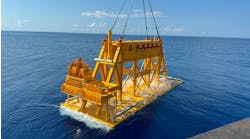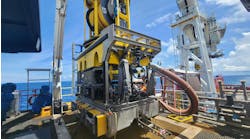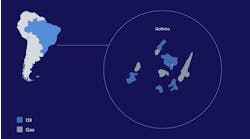Editor's note: This article first appeared in the 2023 Executive Perspectives Special Report, which published within the November/December 2023 issue of Offshore magazine.
By Sonya Boodoo, Rystad Energy
Offshore oil and gas activity is on the rise this year following several lean years for the sector. Increased project sanctioning activity means offshore is the supply segment that has seen the strongest growth in investment in 2023, with Rystad Energy estimating the current high level of sanctioning will be sustained, keeping investment in the offshore sector robust. Increased activity will ultimately lead to strong growth in deepwater liquids supply, meaning deepwater will be a key source of new production globally. Here, Rystad Energy investigates global trends in offshore investment, the contribution of offshore production and the performance of offshore projects compared to other segments.
Investments
Offshore investments declined significantly from 2014 until 2021 amid the oil industry downturn in the middle of the last decade, falling almost 60% over the period to about $138 billion. Last year we observed a change in trends, with offshore investments growing almost 20% from the previous year. This growth has continued this year, with an additional growth of more than 15% over last year. This level of activity, about $200 billion per annum, is expected to be maintained until 2026 (Figure 1). In total, offshore oil and gas investments make up between 30% and 35% of total upstream investments.
Despite the declining trend from 2014 to 2021, there has been an increase in offshore sanctioning activity since the low of $30 billion of project capital expenditure sanctioned in 2016. The expectation is that offshore oil and gas projects requiring $108 billion of capex will be sanctioned this year, surpassing 2019 levels. By 2025, Rystad expects committed capex to continue increasing to $122 billion. It is notable that committed capex is not expected to return to the highs seen in the early 2010s.
This is not a result of reduced sanctioning activity but is driven by cost efficiency measures undertaken by operators.After 2014, the volume of sanctioned resources increased more than fourfold from 6 Bboe to 27 Bboe in 2021. Despite more volumes being sanctioned, however, costs remained depressed as the development cost per barrel dropped significantly from the 2013 high of $18 per boe to an average of $8 per boe between 2013 and 2022 (Figure 2).
Production
Growth in offshore supply is another emerging trend in the upstream sector. Assessing year-over-year growth in non-OPEC liquids supply, it is evident that shale has historically been the key growth driver. After 2020, however, offshore deepwater has in particular shown signs of becoming a key growth segment. In 2023, the growth rate for non-OPEC deepwater is expected to be about 500,000 bbl/d, or 7%, over last year. By 2026, Rystad sees a shift from shale being the biggest growth segment, with offshore deepwater taking its place and remaining the key growth driver at least toward the end of the decade (Figure 3).
Performance
The performance of offshore fields has consistently surpassed that of onshore. On average, deepwater oil wells have estimated ultimate recovery (EUR) of 15 MMboe, shelf wells come in on average at about 5 MMboe and onshore wells at less than 1 MMboe. It is also evident that offshore well performance has been increasing slightly in recent years, with higher EURs toward 2022 (Figure 4).
Figure 5 below compares offshore with other key supply segment groups on various metrics.
The combined undeveloped liquid resource for offshore deepwater and shelf is larger than for any other segment, at about 180 Bboe. The breakeven price for offshore projects in the low $40s per barrel is among the most competitive, outcompeted only by onshore OPEC. With regard to payback time, tight oil is the only segment that offers lower average payback time than the six years for deepwater and 10 years for offshore shelf. The internal rate of return for offshore deepwater at 31% is second only to tight oil. In terms of CO2 intensity, offshore is best in class, coming in at 10 to 12 kg of CO2 per boe, well below most other segments.
The sector’s performance on key metrics suggests that offshore is one of the safer segments in which to invest, providing low breakevens, high returns and a relatively low-carbon footprint. As such, offshore remains a key segment to watch in the upstream landscape.
About the author: Sonya Boodoo is vice president in the Upstream Research team at Rystad Energy, responsible for covering E&P activity on the UKCS and development of the UKCS Business Development Solution. Prior to joining the Rystad Energy, she worked as a geologist and economist for both E&P companies and consulting firms. She holds a BSc in petroleum geoscience from the University of the West Indies and an MSc in energy economics from the University of Dundee.









